
The Sonoran Desert is a hot desert in North America and ecoregion that covers the northwestern Mexican states of Sonora, Baja California, and Baja California Sur, as well as part of the southwestern United States. It is the hottest desert in both Mexico and the United States. It has an area of 260,000 square kilometers (100,000 sq mi).

The dark-eyed junco is a species of junco, a group of small, grayish New World sparrows. The species is common across much of temperate North America and in summer it ranges far into the Arctic. It is a variable species, much like the related fox sparrow, and its systematics are still not completely resolved.

Stenocereus is a genus of columnar or tree-like cacti from the Baja California Peninsula and other parts of Mexico, Arizona in the United States, Colombia, Costa Rica, Guatemala, Venezuela and the West Indies. The genus has been enlarged by the addition of species from several other genera. A close relative is the peculiar chinoa or chende cactus, Polaskia chende.

Lepidium is a genus of plants in the mustard/cabbage family, Brassicaceae. The genus is widely distributed in the Americas, Africa, Asia, Europe, and Australia. It includes familiar species such as garden cress, maca, and dittander. General common names include peppercress, peppergrass, pepperweed, and pepperwort. Some species form tumbleweeds. The genus name Lepidium is a Greek word meaning 'small scale', which is thought to be derived from a folk medicine usage of the plant to treat leprosy, which cause small scales on the skin. Another meaning is related to the small scale-like fruit.

Stenocereus thurberi, the organ pipe cactus, is a species of cactus native to Mexico and the United States. The species is found in rocky desert. Two subspecies are recognized based on their distribution and height. The Organ Pipe Cactus National Monument is named for the species. Cacti are minimally adapted to particular thermal niches, and are tremendously vulnerable to seasonal precipitation.

Stephanomeria is a genus of North American plants also known as wirelettuce, belonging to the tribe Cichorieae within the family Asteraceae.
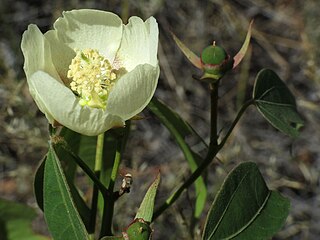
Gossypium thurberi, also known as Arizona wild cotton, Thurber's cotton, or desert cotton, is a wild species of cotton.
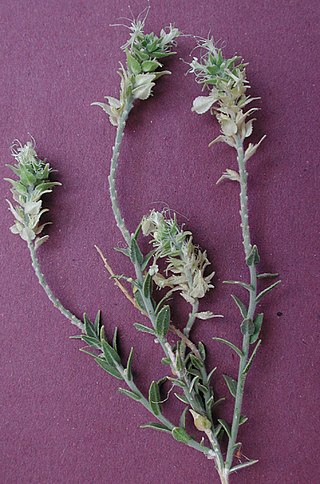
Petalonyx is a small genus of flowering plants native to the southwestern United States and northern Mexico. They are known commonly as sandpaper plants, and are most often found in warm, dry desert regions. Sandpaper plants are subshrubs that get their common name from their rough foliage, which is covered in tiny, stiffly curved hairs. They bear racemes of claw-shaped flowers with long stamens extending well beyond the corolla, and unusual in that they emerge from outside the corolla.
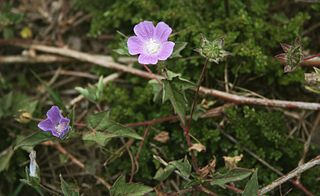
Anoda is a genus of flowering plants in the mallow family. There are 23 or 24 species of these herbs, most native to Mexico and South America. They are generally erect plants with a variety of leaf shapes, and many bear colorful flowers. Most bear distinctive disk-shaped segmented fruits.

A pitaya or pitahaya is the fruit of several different cactus species indigenous to the region of southern Mexico and along the Pacific coasts of Guatemala, Costa Rica, and El Salvador. Pitaya is cultivated in East Asia, South Asia, Southeast Asia, the United States, the Caribbean, Australia, Brazil, and throughout tropical and subtropical regions of the world.
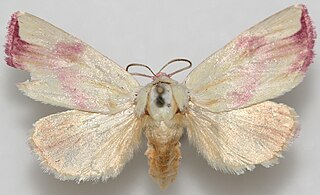
Thurberiphaga is a monotypic moth genus of the family Noctuidae erected by Harrison Gray Dyar Jr. in 1920. Its only species, Thurberiphaga diffusa, was first described by William Barnes in 1904.
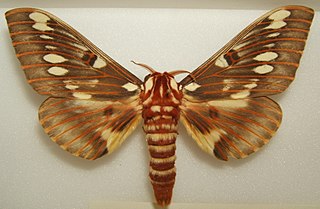
Citheronia splendens, the splendid royal moth, is a moth of the family Saturniidae. It is found from southern Arizona south into central and south-eastern Mexico. The species was first described by Herbert Druce in 1886.
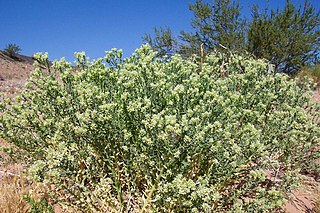
Petalonyx thurberi is a species of flowering plant in the family Loasaceae known by the common names Thurber's sandpaper plant and common sandpaper plant. It is native to the deserts of the southwestern United States and northwestern Mexico, where it grows in sandy and scrubby habitat. It is a rounded or spreading, clumpy subshrub made up of many rough-haired stems approaching one meter in maximum height. The stems are lined with clasping leaves varying in shape from lance-shaped to triangular to oval and sometimes toothed. The inflorescence at the end of the stem is a small, crowded raceme of several flowers. The white flower appears tubular, its petals fused near the spreading tips but open lower, the stamens emerging from outside the corolla.

Pilostyles thurberi is a species of endoparasitic flowering plant known by the common names Thurber's stemsucker and Thurber's pilostyles. It is native to the southwestern United States and northern Mexico, where it grows in desert and woodland. In the United States, P. thurberi has been recorded from the states of Arizona, California, New Mexico, Nevada, Texas.

Festuca thurberi is a species of grass known by the common name Thurber's fescue. It is native to a section of the western United States encompassing New Mexico, Utah, Colorado, and Wyoming. It probably also occurs in parts of Arizona.
Acourtia thurberi, or Thurber's desertpeony, is a North American species of plant in the family Asteraceae. It is native to the Sonoran and Chihuahuan Desert regions in northern Mexico and the southwestern United States.
Helenium thurberi is a North American plant in the sunflower family, commonly known as Thurber's sneezeweed. It is native to Mexico and the southwestern United States (Arizona).

Ferocactus gracilis, the fire barrel cactus, is a species of Ferocactus from Northwestern Mexico. This cactus gets its common name from the striking red coloration of its defensive spines and flowers.
















